It is over 3000 years since a relatively insignificant 19-year-old pharaoh was buried in the Valley of the Kings in a ritual designed to ensure his immortality. The discovery of his tomb by Howard Carter in 1922 ensured that the boy-king lives on, most recently at the Melbourne Museum. Tutankhamun and the Golden Age of the Pharaohs is the latest exhibition in the Winter Masterpieces series aimed at luring people from across the nation to Melbourne during its cooler months. The promise of riches and ritual from ancient Egypt associated with inarguably the most famous pharaonic name (in death if not in life) has drawn crowds of more than seven million people in the United States and Europe — now it's Melbourne's turn. Visitors to the museum are able to experience a collection of 18th-Dynasty Egyptian antiquities organised by the National Geographic Society, Arts and Exhibitions International and IMG Arts and Entertainment, in co-operation with the Egyptian Supreme Council of Antiquities. The exhibition includes a collection of Tutankhamun's treasures that for over 20 years were banned from leaving the Cairo Museum.
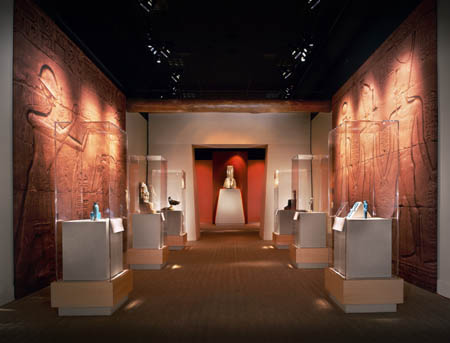
On entering the exhibition, groups are ushered into a dimly lit room illuminated by lamps with images of ankhs and scarabs, where a short introductory video introduces the disarray and turmoil of the reign of Akhenaten, Tutankhamun's father. The unrest highlighted in the video is poignantly juxtaposed against the solitary statue of the boy-king, presented in the next gallery, who took on the task of correcting the unpopular religious revolution of his father. From here, the visitor is directed through the exhibition according to a series of themes. The first themes, 'Daily life'; 'Traditional beliefs'; 'Death, burial and the afterlife' and 'Religion and evolution' frame the period before Tutankhamun took the throne. The final themes, 'Tutankhamun' and 'Discovery' reintroduce the boy-king through the riches located in his tomb and the moment of discovery.
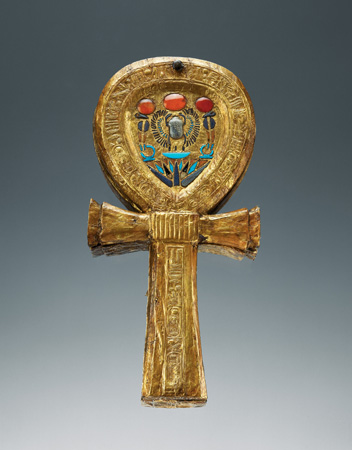
The galleries dedicated to the period before Tutankhamun display funerary items of rulers such as Amhenhotep II and III as well as members of the elite. These items — gilded wood and faience figurines, carved limestone stelea, faience models, wooden chests with ebony and ivory inlays, beautifully carved calcite canopic jars (vessels for the viscera of the deceased) and exquisite gilded funerary masks — evoke a sense of awe and an appreciation of the wealth and craftsmanship of the 18th Dynasty. The highlight is undoubtedly the gilded coffin of Lady Tjuya; resplendent and serene, her eyes inlaid with obsidian and calcite set in glass, her broad collar of row upon row of semi-precious stones and the coffin replete with hieroglyphic texts in raised relief.
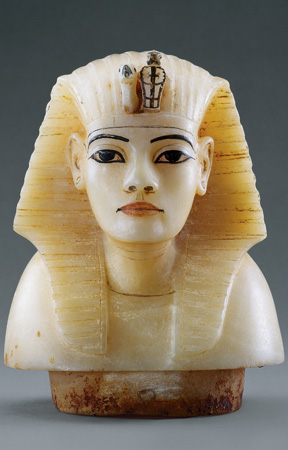
But it is the treasures from Tut's tomb itself that are the real drawcard. When Carter first peered into this tomb he saw 'everywhere the glint of gold', and this is what the visitor can expect in the final galleries. Gold, silver and other semi-precious stones glisten in their brilliance. They not only attest to the skill of the state's artisans but to the concern for Tutankhamun to be appropriately equipped for the next life.
Among the items on display from Tutankhamun's tomb is the stunningly beautiful coffinette that features in the advertising for the exhibition. The use of this miniature coffin in promotion is curious as its similarity to the iconic death mask, not on display, is striking. From conversations with past and prospective patrons, as well as a scan of the 'Your comments' section of the museum website, many people believe it to be the death mask (though the fine print does say otherwise) and express some confusion, surprise and even disappointment at the absence of the mask from the exhibition.
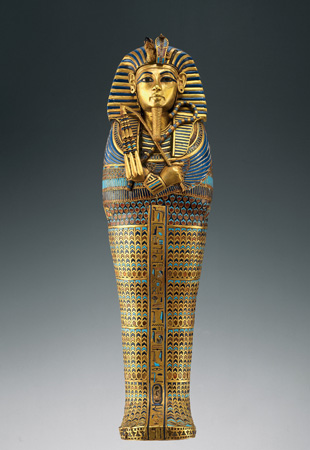
The final theme, 'Discovery', integrates original, simple yet evocative photographs with film and quotes from Carter and perhaps the most beautiful of all the finds — royal regalia, pectorals and diadems, a ceremonial dagger, gilded wood fans and musical instruments — in a way that encourages the visitor to share in Carter's breathtaking moment of discovery. In death, Tutankhamun was placed in a series of nested sarcophagi surrounded by a series of gilded wood shrines. These are presented as reconstructions in an accompanying video, but an appreciation of their scale is gained by tracing brass inlays on the floor that surround a projected image of the mummified body.
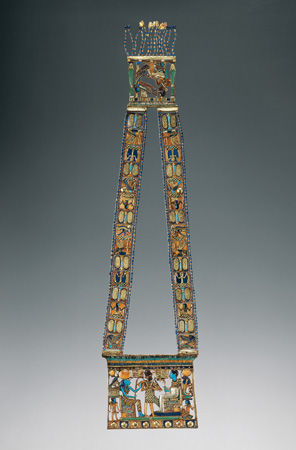
Rooms are replete with backdrops of hieroglyphs that provide a subtle Egyptian ambience, without detracting from the main display. Rather than attempting to recreate the context of finds, the focus is on contextualising the artefacts within the selected themes, which generally works well and encourages the viewer to do more than simply 'look at ancient stuff'. Each display cabinet provides two sizes of textual descriptions, with large print at the top and a smaller font placed below objects. The duplication of information here is useful, as it provides an option to read information from a distance while waiting for others to move on. Sometimes, however, the lighting is so dim that it is hard to read the text. The soft lighting, background music and nature of the collection itself combine to create a curious phenomenon that seems to affect each group that passes through: a hushed and respectful solemnity.
Objects are generally given their own dedicated space in display cases that usually allow for a 360-degree view. Here the dim lighting works in conjunction with the clear glass to create a sense of intimacy that allows the observer to get up close and personal with each artefact. This intimacy enables an appreciation of the detail invested in so many of the objects, such as the fastening apparatus on brooches, the inlay in the side of chairs, the inscriptions adorning the rear of statuettes, the detail in the carved relief. There is little encouragement to stop and ponder for long though. What limited seating is provided is tucked away in corners, implying it is to be used strictly for resting and not for lingering over any particular item, and presumably in anticipation of high visitor numbers.
The exhibition offers a range of visitor experiences. People may choose simply to view the artefacts through the exhibition proper and be satisfied with the accompanying descriptive text. Others may opt for a slightly more informative experience via eloquent audio narration by Omar Sharif. For those wanting to immerse themselves in 'Tutmania', the exhibition is complemented by an easily navigable website with links to information on mummification, curses, timelines, an image gallery and related resources, as well as a series of public lectures. School groups are particularly targeted, with a range of downloadable information packages available for various levels of education. The exhibition catalogue, accompanying guide and other publications are available for purchase along with the predictable key rings, pens and pencils, fridge magnets, bookmarks, cups and the like.
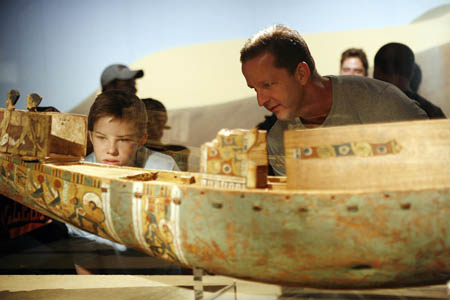
Video is used sparingly to highlight specific items, and a film, Egypt 3D, is an optional extra. This film is best seen prior to the main exhibition. For those who don't feel nauseous watching 3-D, it sets the scene for an adjunct theme of the exhibition, the marriage between science and mummies. The film explores how DNA extracted from mummies found in the Valley of the Kings has the potential to assist in current medical research. While not raising any of the ethical issues associated with these intrusive procedures, it does set the stage for the science that surrounds Tutankhamun's lineage and the changing view of his demise. The current understanding of Tutankhamun's family tree is presented in a genealogical chart in the early stages of the exhibition. For the curious minded, more information can be found at the base of the elevator on the way to the main exhibition. Here a history of scientific techniques as they have been applied to Tutankhamun and other mummies is presented that explains the changing views of his death, ancestry and offspring. This is an integral and exciting aspect of the exhibition that should not be missed; especially as the information offers an addendum to the official catalogue produced before the most recent findings published in 2010 in the Journal of American Medical Association. In this room, the visitor can also take a virtual tour of Tutankhamun's tomb, gaze upon the only cast made of his mummified body and come face to face with the 'living' boy-king through a forensic reconstruction of his face.
A victim of its own blockbuster success, on-line booking is mandatory for guaranteed entry and provides the benefit of not having to wait in long queues; but not queuing somehow detracts from a 'blockbuster experience' and may leave a sense of being robbed of the shared group experience of mounting excitement and anticipation. Irrespective of these issues, given that many Australians will never visit Egypt, this exhibition may truly be a once in a lifetime opportunity and it would be remiss not to take advantage of it before it heads home to Cairo in early December 2011.
Janine Major is an associate lecturer and doctoral candidate in the Archaeology program at La Trobe University, Melbourne, researching Natufian (Epi-palaeolithic) art from the Levant, particularly its distribution, processes of manufacture and relationships between media, motif and artefact type.
| Exhibition: | Tutankhamun and the Golden Age of the Pharaohs |
| Exhibition creators: | Egyptian Supreme Council of Antiquities, National Geographic Society, Arts & Exhibitions International and IMG |
| Lead curator, advisor and academic content creator: | David P Silverman |
| Venue/dates: | Melbourne Museum, 11 Nicholson Street, Carlton, Victoria, 8 Apr 2011 – 4 Dec 2011 |
